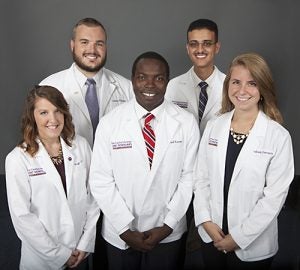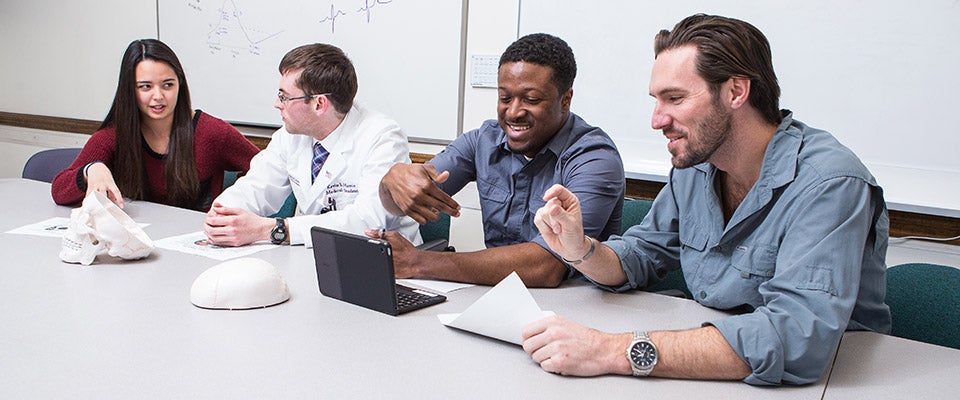RIGHT ON TRACK
Program encourages medical students to pursue passions
A new program at the Brody School of Medicine at East Carolina University encourages medical students to pursue their individual passions and get academic recognition for those pursuits.
According to Brody leaders, the new program – called “Distinction Tracks” – reflects the core values that have always permeated Brody’s culture. But they say the structure provides a mechanism for formally recognizing outstanding accomplishments of Brody students.
“Traditionally, the first three years of medical school have been training an undifferentiated physician; everyone takes the same courses and has the same experiences up until the fourth year,” said Dr. Robert Carroll, associate dean for medical education at Brody.
“But the fourth year is late in the game to begin differentiating,” Carroll continued. “We want to provide motivated students the chance to engage earlier on in professional development experiences based on the personal interests that led them to a medical career in the first place.”
Choosing a path
There are four Distinction Tracks that first-year medical students can now apply for: Healthcare Transformation and Leadership, Research, Service Learning, and Medical Education and Teaching. The first two were launched during the summer of 2015 with about 20 students between them. The others will formally begin this summer.
Selected students engage in an intense, eight-week immersion course between their first and second years of medical school. Following the summer immersion experience, students engage in longitudinal, advanced, mentored learning throughout their remaining three years of medical school.
“Each track incorporates ongoing, independent activities designed to promote immediate application of knowledge and experiential learning,” said Dr. Luan Lawson, assistant dean for curriculum, assessment and clinical academic affairs at Brody.
“The experience culminates with a month-long capstone experience in the fourth year where students will present a final scholarly project,” said Lawson, noting that each track has designated faculty members who closely mentor students throughout the process.
Preparing to lead
Second-year medical student Zachary Williams is participating in the Healthcare Transformation and Leadership track, which equips students to be leaders and change agents with advanced expertise in patient safety, quality improvement and team-based care.
Williams found special significance in the field experiences he participated in last summer as a rising second-year student with no clinical training under his belt yet. His cohort completed a clinical navigation exercise in which each medical student shadowed a patient from their arrival in the parking lot through the checkout process, analyzing every interaction along the way. They identified what worked well from a patient and family perspective – and made recommendations where they saw opportunities for improvement.
“That firsthand experience, along with other teamwork and communication activities we did, helped me better understand the functioning dynamics and different elements of effective teams,” Williams said. “It also opened my eyes to issues like data management, timely communication and patient privacy considerations and helped prepare me to lead some of the changes that need to happen in the future of medicine.”

Second-year medical students participating in Brody’s new Healthcare Transformation and Leadership Distinction Track are (from left) Paige Driver, Zachary Williams, Ismail Kassim, Taj Nasser and Elizabeth Ferruzzi. (Photo by Gretchen Baugh)
“We’ve found that clinical training isn’t necessary for students to be able to recognize certain quality and system issues and to recommend positive changes,” said Dr. Elizabeth Baxley, senior associate dean for academic affairs at Brody. “By starting them on this track early, we can equip them to become better health care leaders and patient advocates.”
Part of a community
Williams’ classmate Shelby Powers is on the Research Distinction Track toward her career goals. This track allows students to pursue clinical, basic science and translational research to characterize the mechanisms of diseases, the factors influencing health and the therapies used to improve health.
The program supported Powers’ recent attendance at the annual meeting of the International Society for the Study of Women’s Sexual Health, where she presented some of her research findings and networked with others in her field of interest. As a result of her engagement in the distinction track, the American Urological Association has awarded Powers a fellowship to pursue an additional research project this coming summer.
“Experimental findings in the lab are incredibly exciting,” Powers said, “but the ability to share them with the greater scientific community has added value to my experience as a scientist and emphasized the importance of my future engagement with research as a physician.”
Powers said completing the research track would strengthen her residency applications. “Many competitive residency positions are looking for students who have shown initiative in areas other than medical education,” she said. “Participation in areas of active and relevant medical research is both personally fulfilling and a way to distinguish myself from other residency applicants.”
‘A win for everyone’
Medical students who desire to work domestically and internationally with medically underserved, marginalized and rural populations can find additional training, support and encouragement in the Service Learning Distinction Track.
And for those with academic aspirations, the Medical Education and Teaching Distinction Track prepares students to be effective medical educators and develops their interest in academic medicine through the application of learning theory and instructional strategies.
“The Distinction Tracks Program is a great benefit to our students because it offers them the opportunity to earn additional certification beyond their medical degree,” said Carroll. “The distinction is noted on their transcript, and the experiences will strengthen their residency applications.
“But also, their research activities are advancing science. Our community benefits from the services these students provide. And patient care is impacted through efforts like their quality improvement projects. It’s a win for everyone.”
Carroll said Brody administrators are aiming for about 40 percent student involvement in the distinction tracks. They want to keep the program competitive and ensure that its completion remains a true distinction.
He noted that only a few medical schools in the nation have implemented similar programs.
